Nth Generation Computing Scores With End-User Conference
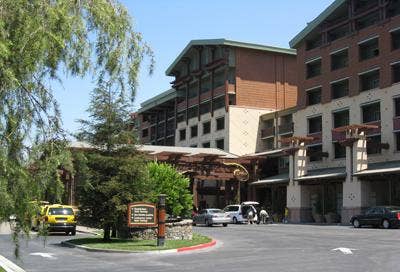
Nth Generation Computing chose Disney's Grand Californian Hotel in Anaheim, Calif. for the site of the event. The hotel is just steps from Disneyland and the Downtown Disney shopping area, giving the family members of attendees and Nth employees something to do while others suffered the air-conditioned comfort of the hotel.
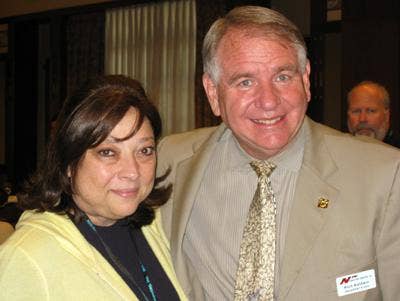
Rich Baldwin, president and CEO of Nth, has over the past eight years built a reputation among customers for his company's annual Technical Symposium, a fact not lost on his peers.
Among those attending the event on Tuesday and Wednesday was Felise Katz, CEO of PKA Technologies, a Suffern, N.Y.-based solution provider.
Katz (left) and Baldwin (right) have been friends for over a decade. They, like many of today's HP solution providers, worked together at DEC when that company was among the pioneers of the modern storage industry.
Katz, whose company has put on regular day-long customer events, flew to Anaheim specifically to see how Nth was able to put together a multi-day event. She said she plans to offer such an event this December. "It's impressive what Rich has done here," she said.
Baldwin said he got as much from Katz's attendance. "Having Felise here and her feedback is really nice," he said.
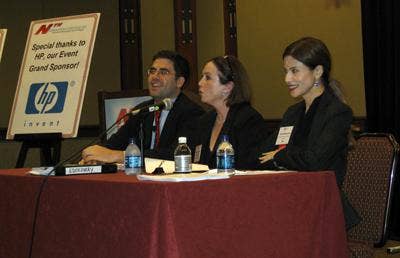
After the morning greetings and opening sessions including presentations by two of the sponsors of the event, Xiotech and Hewlett-Packard on Tuesday, the highlight of the afternoon was a presentation by a pair of attorneys and a high-profile judge who discussed the importance of e-discovery.
The Honorable Maureen Duffy-Lewis (center), a judge at the Los Angeles Superior Court, said that what happens when businesses get to the courthouse depends on what they do before a lawsuit is filed.
Often, a business will get word of a pending lawsuit, giving them time to sit down and understand what electronic records may be required, Duffy-Lewis said. "All discovery doesn't always lead to relevant trial-admissible evidence," she said.
Some lawyers understand e-discovery, while many others do not, Duffy-Lewis said. "Sometimes, it gets so bad I will retire to my chamber with the lawyers so we can get acquainted with each other and get everyone up to speed," she said.
Duffy-Lewis was flanked by Daniel Garrie, attorney and partner at CRA International (left), and Liane Komagome, principal and director of electronic discovery and legal business consulting for CRA International (right). Garrie and Komagome detailed the e-discovery process and some of the issues nearly every enterprise will face as part of litigation.
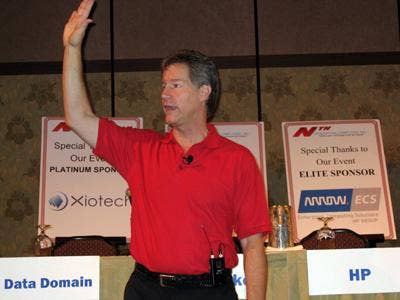
John Randall, marketing director for Nth Generation, opened the second day of the event on Wednesday by encouraging attendees to visit the demonstration lab which the solution provider set up at the hotel.
Most of the equipment in the lab was brought over from Nth's own $3 million lab in San Diego, Randall said. "I think we draw more power at this hotel than any other show held here," he said.
Randall also outlined the opportunities for attendees to walk away with prizes. The solution provider gave every attendee who visited its professional services booth to hear about the promotional special an opportunity to win a 42-inch plasma TV from HP. Attendees who also agreed to a 90-second interview on video also got an additional five tickets to win the TV, thus assuring Nth several testimonials it could use later.
Randall introduced the afternoon's breakout sessions, noting that Nth offered a total of ten breakouts. "The biggest joy I get is when you say, John, I don't know what breakout to go to," he said. "I like it when you are conflicted. It makes you bring your friends so you can cover all the sessions."
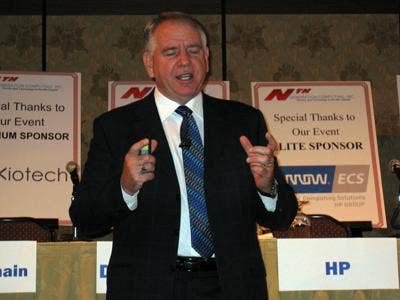
Rich Baldwin, president and CEO of Nth, talked about his company and the challenges of the storage industry.
Baldwin noted that in the 1960, the equivalent of 1 Tbyte of disk storage would have cost about $3.5 billion, compared to the $89 someone would pay this week for four 250-Gbyte hard drives on eBay in a Buy-It-Now auction. "In 1967, I paid $1,625 for my VW Beetle," he said. "If the price for cars fell at the same rate as storage, that VW Beetle would cost about 3.7 cents today."
The falling cost of storage has corresponded with an increase in the need to manage it, Baldwin said. Unfortunately, he said IT budgets are not rising to the challenge. When he asked the audience how many companies saw their IT budgets increase this year over last year, only two people raised their hands.
Baldwin used his personal obsession with photography to illustrate the growth of storage. He spent the previous three weeks in Italy where he shot a total of 8,219 digital photos. His Canon IDS Mark III 21 megapixel camera can take one or two copies of each photo, either in the large JPEG format at 14 Mbytes to 18 MBytes per photo, or in the RAW format at 18 Mbytes to 25 Mbytes per photo, giving him a total of 111 Gbytes worth of photos.
Those photos were added to his personal file folder, which occupies 1.89 Tbytes on the company SAN. "It's a good thing I own the company," he said.
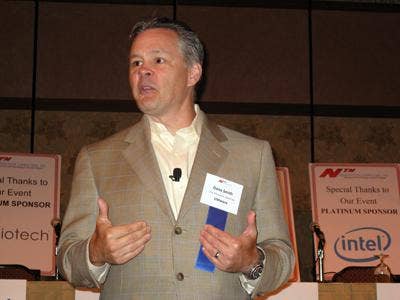
Dane Smith, vice president of Americas Field operations at VMware, told audience members that change in the data center is happening rapidly, especially in terms of the adoption of virtualization technology to consolidate hardware and reduce costs and power use.
However, for many companies considering adopting virtualization technology in their data centers, culture is the number one barrier to change, Smith said. "They'd rather have the devil they know than the devil they don't," he said. "But remember the Law of the IT Jungle: If you don't like change, you'd better like irrelevance."
Smith said VMware is happy to see competitors such as Citrix, Red Hat, and Oracle enter the server virtualization market, as they increase what is still a tiny penetration of the potential market. "I hope Circuit City and Best Buy get in," he said. "I hope Disneyland gets in."
Smith said VMware is even happy to see Microsoft with its Hyper-V technology, which he referred to has "Hyped-up V," in the market, and took the opportunity to show how the cost of adding a virtual server using Hyper-V actually can cost more than the same operation using VMware's ESX.
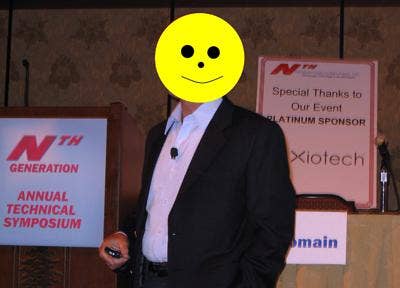
Next, an enterprise customer of Nth's discussed his company's move to adopt desktop virtualization for over 40,000 users.
The IT director of the customer, who asked ChannelWeb to not identify him publically, said his company already has 71 servers hosting 669 virtual servers, resulting in a tremendous cost savings.
The company recently decided to move to a virtual desktop environment in order to better manage its core operating environment, cut operating costs, and increase the security of critical data against threats that are growing both in volume and sophistication.
The company developed a security threat assessment for management, and sequestered several line personnel from around the company for two weeks to give feedback about virtual desktop PCs and possible solutions.
The virtual desktop PC implementation was done differently for three groups of users, the customer said. Users who don't need local administration rights, such as the ability to load applications without authorization, received virtual desktops that are streamed over the network, or come via thumb drives or network shares. Those who need those rights got security training with virtual operating systems on their desktops. And users who work at customer sites or at home got thin clients, remote desktop protocol, or Web-based access.
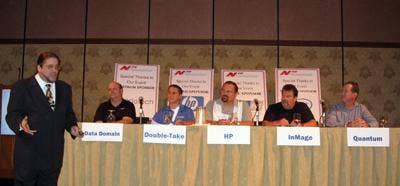
Jon Toigo, CEO and managing partner of analyst firm Toigo Partners International, of Dunedin, Fla., moderated a panel of storage vendors including executives from Data Domain, of Santa Clara, Calif.; Southborough, Mass.-based Double-Take Software; HP, of Palo Alto, Calif.; InMage Systems, Santa Clara, Calif.; and Quantum, of San Jose, Calif.
Toigo started by listing the four topics most on customers' minds, including cost containment, compliance and governance, carbon footprint, and continuity and disaster recovery.
IT vendors have a responsibility to their customers to overcome these issues, especially those related to business continuity and disaster recovery, Toigo said. "Disaster recovery is dead," he said. "We shouldn't be doing it any more. It should be built-in, not bolted on. . . . Most of what we are doing is like rearranging the deck chairs on the Titanic."
Toigo also chided audience members about their own responsibilities, saying that IT managers tend to be platform-focused instead of business process-focused. "But disaster recovery is not about recovering the platform," he said. "It's about recovering the business."
Fewer than 50 percent of organizations have disaster recovery or business continuity plans, and few than 50 percent of those organizations test their plans, Toigo said. "And that's the equivalent of having no plan at all," he said.
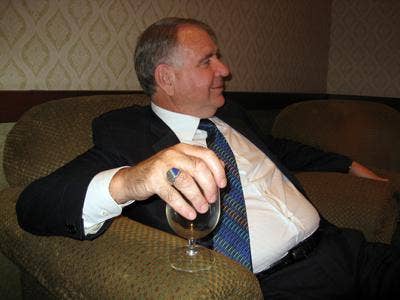
Baldwin estimated that up to 300 customer personnel and about 160 employees of vendors and other partners were at the event. Among the presenters was Casey Powell, president and CEO of Xiotech, of Eden Prairie, Minn., and Rudi Schmickl, vice president of enterprise servers and storage for HP's Technology Solutions Group.
Baldwin gave credit for the success of the event to his staff, saying that he was on vacation for the three weeks prior to the event, and basically came home and found the event all ready to go.
The event was quite large for a 60-person company with annual revenue of about $38 million. "We've always generated an image that we are bigger than we are," Baldwin said. "In our industry, there aren't a lot of companies our size with so few people."
The majority of Nth's staff was also at the event. "A lot bring their families," Baldwin said. "A lot of them look forward to this event. They and their families get to stay in a five-star hotel. The families get together during the day to go to Disneyland."
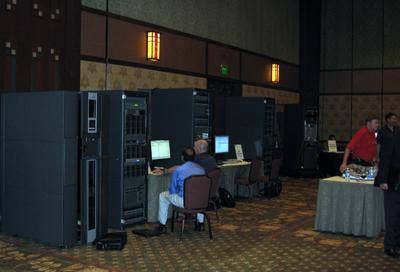
Nth opened its interoperability lab after mid-afternoon all three days, and earlier in the day by appointment.
The 28 stations in the lab included most of the company's equipment from its $3 million demo data center, trucked from San Diego to Anaheim in three semi-trailers.
The lab included the latest equipment from several vendors, highlighted by products from HP, which is Nth's biggest partner. For instance, HP and Nth personnel were showing that vendor's updated Integrated Archive Platform, which can ingest and archive up to 1.4 emails per day in its smallest configuration. The vendor is planning to shortly release an upgrade integrating the compliance technology it got last March with the acquisition of Tower.
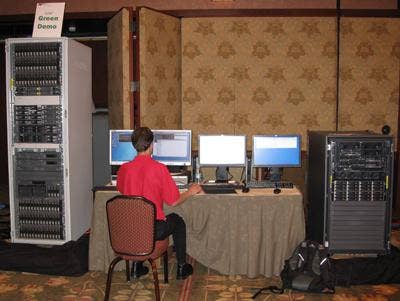
One of the stations in the demo lab compared the power consumption of a five-year-old HP EVA 5000 storage array connected to seven servers to that of a modern EVA 4400 and new HP C-class server blades.
The older system was using 33.3 Amps of power, compared to 11.9 Amps for the newer system, resulting in a savings on electricity of $2,678 for a system with much greater performance, according to Nth personnel.
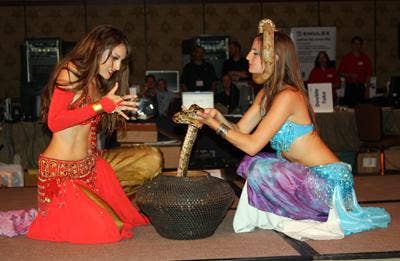
The highlight of Nth's Technical Symposium was a performance by the Shimmy Sisters, a San Diego-based troupe of belly dancers. They performed on the stage in the center of the interoperability lab.
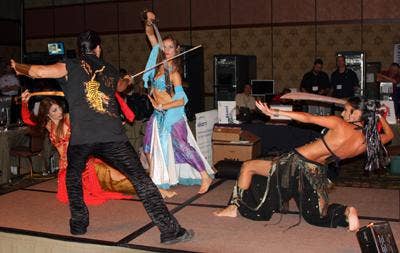
The Shimmy Sisters is a family-based troupe, and their show included several different dance forms such as snake dancing and sword dancing.
The troupe has appeared in such venues as Las Vegas and Qualcomm stadium, and does performances for private functions as well as charity.
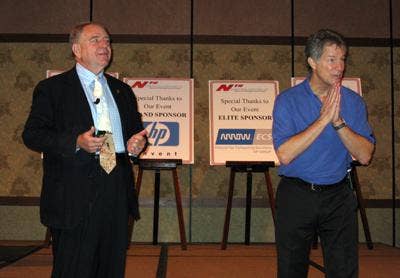
On the third day, after Randall thanked all the Nth staffers who put the conference together, Baldwin (left) thanked Randall (right) for his efforts.
"Here's the real reason we can put on such an event," he said. "John's the one that went to the different vendors and got them to pay for this program. If you wanted to attend another event of this caliber by someone like (analyst firm) Gartner, you'd have to pay $2,000."
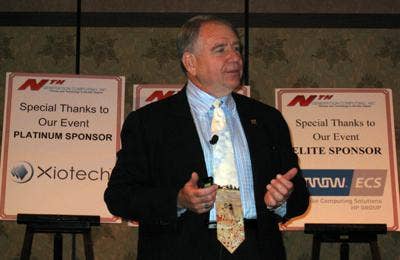
Baldwin opened the last day discussing Nth's customer commitment, including its focus on customer service.
"We sometimes provide the service before we get paid," he said. "Once my professional services manager said on a Friday afternoon that a customer's SAN went down. The vendor's service people couldn't come until the next day. I asked, can we send someone? He said, 'Yes.' The following Monday, we got a purchase order for $75,000 in professional services that we had been discussing with the customers for a long time."
One of the factors behind Nth's success is its ability to retain staff. Nth employees have been with the company an average of 9 years, Baldwin said, in part because they are treated like family and get such perks as Disneyland passes for their families, beach parties, San Diego Padres tickets, and even access to Baldwin's own extensive DVD library with no rental fees or late charges.
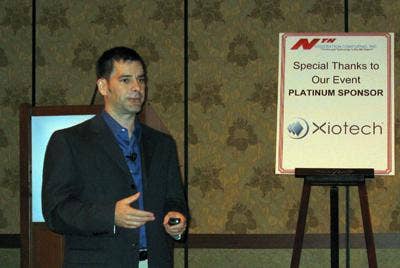
Chris Peters, manager of product marketing at Intel, discussed his company's line of microprocessors, but also reminded the audience that the company also produces chipsets, 10-GbE networking, and solid-state storage technology to support modern data centers.
Peters also briefly discussed upcoming processor platforms, including the Nehalem, expected to be released next year. The Nehalem platform is a six-core processor with dynamic power management, and includes a 16-Mbyte Level-3 cache, an integrated memory controller, native DDR3 memory support, and support for the second generation of PCI Express. Production is expected to start late this year, he said.
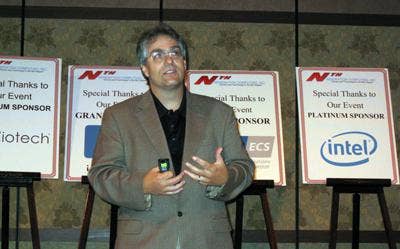
Steve Sicola, CTO of Xiotech, arguably one of the smartest people in the storage industry with over 40 patents and patents pending, talked about the need for storage vendors to go from DUDE, or Damned Undetected Data Errors, to NUDE, or No Undetected Data Errors.
Sicola also said the storage industry needs more CRAP (cost, reliability, availability, and performance).
He also introduced his company's new Intelligent Storage Elements (ISE). These are self-contained, sealed storage modules with hard drives; redundant Managed Reliability Controllers with local RAID, cache, and drive management software; redundant power and cooling; and battery backup for up to 96 hours of protection.
The ISE is part of what Sicola, who is as famous for his acronyms as he is for being the father of HP's StorageWorks line, called a CESSPool, or a Cost-Effective Shared Storage Pool.
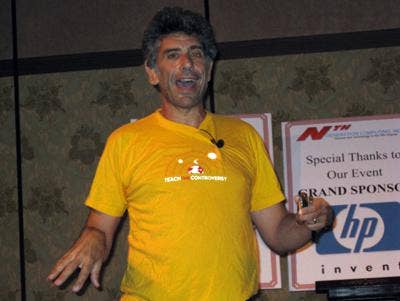
Richie Lary, senior technology consultant at IN_fusion and principle at consulting firm TuteLary, talked about the need to redefine the virtual data center in a presentation he called, "Empowering Information Lifecycle Management through Green Web 2.0 Best-Practices While Avoiding Buzzwords."
Lary said that data centers today are built around the virtualization of storage and servers, but that virtualizing that hardware does nothing to alleviate management issues. "Nobody buys a data center for the joy of managing servers," he said. "And I guarantee nobody is buying a data center for the joy of managing storage."
Instead, what is needed is for companies, especially those who want to be providing services based on cloud computing, to start looking at how to virtualize the applications, Lary said.
He used the AppLogic technology from 3Tera, an Aliso Viejo, Calif.-based startup, as an example. The AppLogic technology automates the virtualization of server, storage, and network resources via a single GUI based on the customer's application requirements, he said.
"I'm not trying to sell this to you," he said. "I'm saying, can you see extending this model to your infrastructure?"
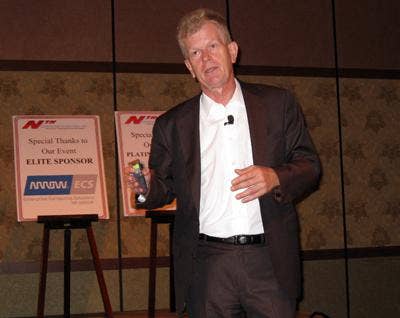
Rudi Schmickl, vice president of enterprise servers and storage for HP's Technology Solutions Group, said it is possible to restructure data center environments to meet such challenges as manageability and power consumption.
He cited HP's own restructuring which consolidated 180 IT sites into 25 sites and 85 global data centers into six locations, reduced IT headcount from 19,000 people three years ago to about 8,000 today, and cut the number of applications the company runs from over 5,000 to the current 1,500.
Schmickl later told ChannelWeb that HP is closely looking at Nth's Technical Symposium as a way to better reach customers when compared to the huge events that are typical in the industry.
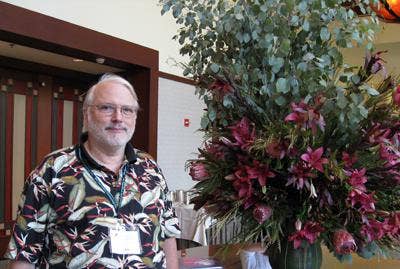
Zygmunt Wiedemann, a senior consultant with Level IV Consulting, a Sunnyvale, Calif.-based consulting company that is both a customer and a partner of Nth, said that Nth's user conferences are among the best he attends. "The information, the delivery, and the logistics involved are remarkable coming from a company that size," Wiedemann said.
Wiedemann said the information from the conference is appropriate, timely, and very useful. "Rich (Baldwin) and his people know the market, they know the sweet spots, and they know how to put it all to use," he said.
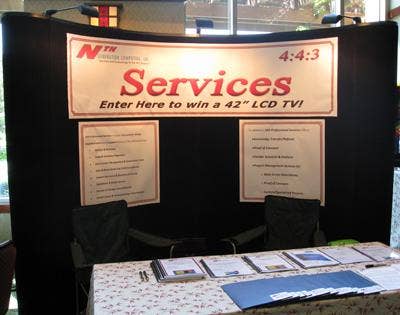
Among other prizes, attendees of the conference were encouraged to visit Nth's professional services booth to sign up for a chance to win a 42-inch TV.
At the booth, they were presented Nth's main promotion of the event. Under the "4:4:3" promotion, customers who signed up for three days of professional services got a fourth day of services free-of-charge.
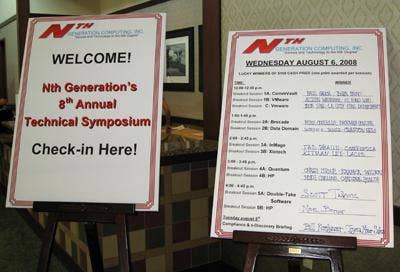
Attendees could also check for their name on a list of $100 winners. During every breakout session, Nth gave $100 to one lucky attendee, giving them multiple chances to win.